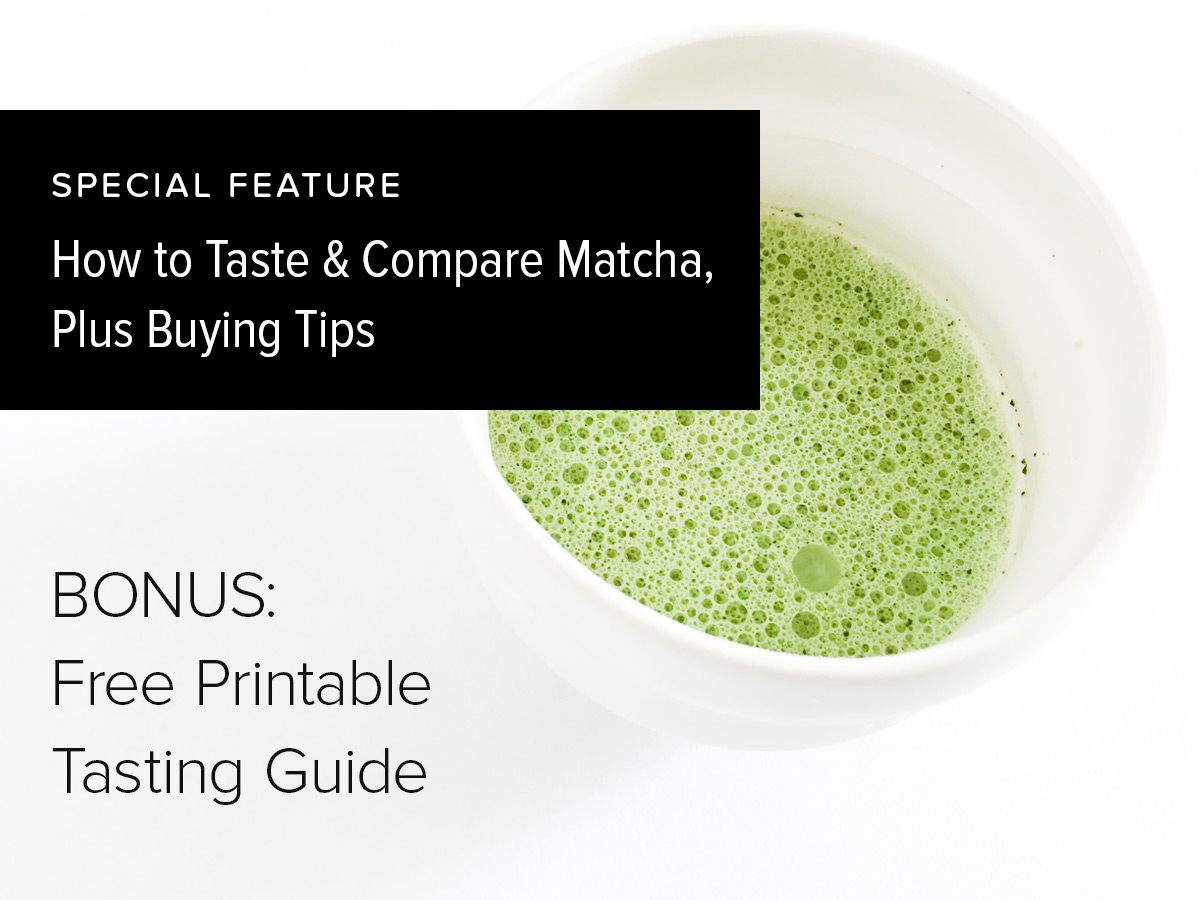
Here at Matcha Reviews my goal is pretty simple: help matcha lovers like myself, as well those newly introduced to this unique form of green tea, find the “best matcha.” How exactly do I do that? Today I’m sharing with you my personal Matcha Tasting Guide, which helps me write each matcha review I post here. Feel free to try it yourself–I’ve included a free printable PDF version of this guide for your matcha tasting pleasure.
How to taste matcha the Matcha Reviews way
Download the free supplemental tasting guide using the form on the right.
Step 1: See
Color: Look for really vibrant green color in the powder. The greener the better. Bad matcha is yellow or brownish in tint.
- Vibrant Green
- Flat Green
- Yellowish Green
- Brownish Green
Foam: After whisking your matcha for about 8 seconds, examine the foam (or lack thereof). There should be nice frothy bubbles on top (like an espresso).
- Foamlike froth
- Full bubbles
- Sparse bubbles
Step 2: Smell
Aroma: Good matcha has a fresh grassy smell. Bad matcha will have a stale hay smell.
- Grassy
- Floral
- Nutty
- Stale Hay
Step 3: Taste
Flavor: Good matcha should have a smooth, clean taste. Bad matcha will taste overly bitter and astringent.
- Nutty
- Earthy
- Grassy
- Bitter
Texture: Good matcha is fine and silky on the tongue. Bad matcha is coarse and gritty.
- Smooth and silky
- Coarse and gritty
Body: Good matcha is thick and creamy. Bad is thin and watery.
- Thick and creamy
- Thin and watery
Finish: Good matcha should have complex notes and a long finish (at least 10 seconds).
- Long (10+ seconds)
- Medium (5 seconds)
- Short (2 seconds or less)
My 5-Point Rating System
After careful tasting and noting my observations, it comes down to how I feel about drinking more of this matcha in the future.
- 5/5 = One of the best matchas I’ve ever tasted. I’ll be buying this again in the future.
- 4/5 = An excellent matcha. I’ll likely be buying more.
- 3/5 = A decent matcha, but I won’t be buying it regularly.
- 2/5 = Not a good matcha, I don’t want to drink it again.
- 1/5 = An awful matcha. I can’t finish drinking it.
See the matcha reviews section for a sortable listing of matchas I have rated so far.
Some general guidelines for buying quality matcha
Now that you have some more concrete descriptions for what you like and don’t like in a matcha, here are a few things to consider in general when buying your next batch.
It’s widely accepted that matcha from Japan is the best. Japan is where matcha was born and they have perfected the process. It starts with using high quality leaves, with stems and veins removed to reduce any bitter flavors. Then the leaves are stone ground to a fine powder in specially designed granite stone mills (non-traditional matcha producers use equipment that can burn and therefore degrade the matcha). In my experience, matcha from Japan has tended to have less oxidation problems, which occur when matcha is exposed to oxygen (the powder turns a brownish green and smells like stale hay in the cup).
Price can also steer you towards higher quality matchas, which are usually more expensive. On the higher end of the spectrum, Ceremonial grade is more complex in taste and aroma due to higher concentration of amino acids. You can often find less expensive Culinary grade versions of the same producer’s matcha, which can be less complex, earthier, and more astringent. This doesn’t necessarily mean Culinary grade is unpleasant (I’ve definitely tasted some good enough to sip on their own), but is usually better suited to mixing into smoothies, lattes, or cooking.
Then there’s the Organic label, which certifies that matcha is grown free of herbicides or pesticides. This label will usually put you in the higher price range, but in my tastings I haven’t found a significant difference in quality between good Organic and good non-Organic matcha. And of course, bad matcha is just bad, Organic or not.
Hope this helps in enjoying your matcha journey! Don’t forget to download your free matcha tasting guide printable using the form on the right.